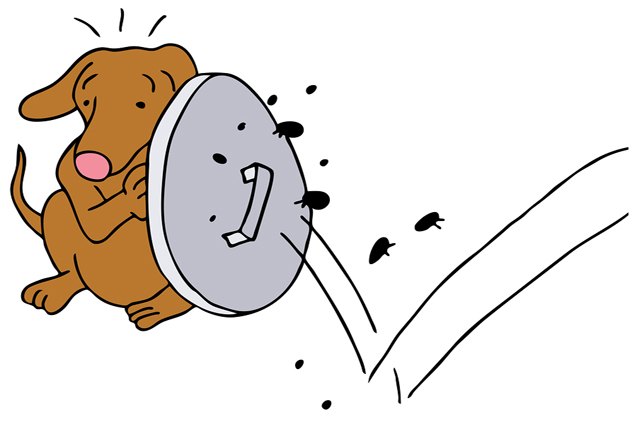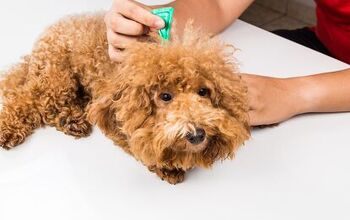Know Your Enemy: Most Common Types of Dog Fleas

Suit up! ‘Tis the season for those nasty little pests to come out of hiding and irritate you and your pet. Be on the lookout for these common types of dog fleas.
If you are a pet owner, you probably know at least a little bit about fleas. Even if you are fortunate enough to have never dealt with a flea infestation, you understand how troublesome fleas can be. There are roughly 2,000 different types of fleas in the world and about 200 species can be found in the United States alone. Different fleas attack different animals, and even people! Be prepared this season and bone up on the types of dog fleas that could cause you some irritation.
Overview of Types of Fleas
Though there are hundreds of different types of fleas, not all of them are known to bite animals and only a few are known to bite humans. Here’s an overview of the most common types of dog fleas you’re most likely to encounter in North America:
Human Flea (Pulex irritans): This type of flea tends to prefer a human host, though it will feed on dogs, cats, and pigs if it has to. The human flea is closely related to the false human flea and the two can often be found on the same host.
Related: What’s The Difference Between Fleas and Ticks?
False Human Flea (Pulex simulans): This flea is similar to the human flea, though it is most commonly found on dogs and cats as well as wild mammals.
Rabbit Flea (Spilopsyllus cuniculi): This type of flea is most commonly seen on wild and pet rabbits, though it does affect dogs and cats as well. Rabbit fleas tend to bite the ears of their hosts, causing papules and crust to form around the edges.
Sticktight Flea (Echidnophaga gallinacean): Also known as the tropical hen flea, this type of flea is mostly known to affect poultry. In some cases, however, it has been known to bite dogs or cats if they are available.
Dog Flea (Ctenocephalides canis): Though this type of flea most commonly bites dogs, it can also be found on cats, humans, and other mammals. Dog fleas are also common on wild raccoons and possums as well as livestock. These fleas are common carriers of the tapeworm parasite.
Cat Flea (Ctenocephalides felis): This type of flea primarily affects domestic cats, though it will bite dogs. These fleas are common carriers of the tapeworm parasite.
Related: 8 DIY Natural Flea Remedies for Your Home
Common Signs of Flea Infestations
Even if you treat your dog every month with a topical flea preventive, you should still keep your eye out for the signs of a flea infestation.
Excessive Itching
The most obvious sign of a flea problem is a dog that is scratching at itself or biting at its skin excessively. Other signs of an itchy dog that may not be as obvious at first glance include scooting on the ground, rubbing themselves against your furniture, obsessive licking, or head shaking.
Hair Loss and Skin Irritation
As a result of all the itching, some dogs will start to experience irritation to their skin. This can present itself in a few different ways, all of which are signs that your dog is experiencing discomfort. Try separating your dog’s fur to check the skin for signs of redness, visible scratches, scabs, or dry skin. If the skin has been irritated enough, you may also see patches of hair loss. This is most common on the head, ears, neck, and at the base of your dog’s tail.
Live Fleas
While fleas are small creatures, measuring only 1-to-3 millimeters long, you may be able to see them moving about your dog’s skin if your look closely enough. They are dark brown or black in color and will stand out most obviously on dogs with lighter-colored fur and skin. Higher risk areas to check include the neck, ears, lower back, base of the tail, and abdomen.
Another easy way to spot live fleas is with the assistance of a flea comb. These fine-toothed combs have teeth that are just far enough to allow your dog’s fur to pass through while trapping the fleas and pulling them free. If you are going to use a flea comb, be sure to have a cup on hand with water and dish soap. Dip the comb in the cup after each stroke of your dog’s fur, trapping the fleas and preventing them from hopping off to hide in your home.
Flea Dirt
In the same areas where fleas are common, you may notice small black flecks that look like bits of dirt or pepper. These are flea droppings comprised of dried blood. If you’re unsure of whether you’re looking at pieces of dirt or flea dirt, try placing them on a damp paper towel. If they are flea droppings, they will absorb moisture from the paper towel and change color from black to brown to red.
If you notice a flea infestation – or if you only see one or two fleas – you need to take immediate action to get the problem under control. Thoroughly vacuum and clean all of the carpets and furniture in your home, including your pet’s bedding. If possible, wash the bedding in hot water to kill any existing fleas. After you vacuum, be sure to throw away the vacuum bag so the fleas don’t crawl back out. You should also call an exterminator or use a DIY flea control product to remove fleas from your pet and from your house.
Complications of Flea Bites
Outside of being an irritation, making your dog feel itchy and uncomfortable, there are some additional complications that you should consider.
Tapeworms
Fleas can carry tapeworm eggs. As a do with fleas is biting at their skin to stop the itch from flea bites, they may ingest a flea containing the eggs. They will then travel through the dog’s digestive system to the small intestine where they can hatch and mature, creating a tapeworm infestation.
Flea Allergy Dermatitis
A common dog skin disease, flea allergy dermatitis refers to an allergic reaction to flea saliva. As the fleas continue to bite the dog, the reaction will continue to grow and worsen. This can lead to intense itching, scaly skin, hair loss, and potentially dangerous skin infections.
Anemia
This is a condition that occurs in dogs that have experienced significant blood loss. It’s usually associated with severe trauma or injuries, but it can also occur from a serious flea infestation. A single flea can consume up to 15 times its body weight in blood every single day, which can add up surprisingly quickly. This is why it is important to address a possible flea infection as quickly as possible.
Dealing with a flea infestation is no easy task so you should do whatever it takes to prevent fleas from becoming a problem in your household. Stay up to date on your dog’s monthly topical flea treatments and keep an eye out for fleas and the signs they leave behind.

Kate Barrington is the loving owner of two cats (Bagel and Munchkin) and a noisy herd of guinea pigs. Having grown up with golden retrievers, Kate has a great deal of experience with dogs but labels herself a lover of all pets. Having received a Bachelor's degree in English, Kate has combined her love for pets and her passion for writing to create her own freelance writing business, specializing in the pet niche.
More by Kate Barrington























